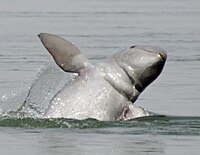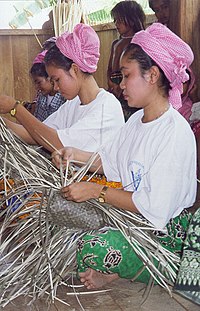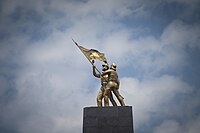Kratié Province
The province’s capital is the town of Kratié located within the Kratié Municipality.
Name
"Kratié" is the French spelling derived from the Khmer ក្រចេះ Krâchéh ([krɑːceh]).
History
The area now known as Kratié was part of the early first millennium Kingdom of Funan until Funan itself was superseded and absorbed in the 6th century by Chenla. Sampheak Borak, the former Royal Capital during the Chenla Era, is located in Sambo District. In addition, Kratié has Vihear Sasar Muayroy Pagoda built in the 16th century. This pagoda is related to a Khmer legend Krapeur Nen Thun (Venerable Monk Thun, the Crocodile). Kratié has several temples built in the 8th century such as Khvas Pi, Pram, and Koh Kring that has perfect deities, ancient halls, Khmer ancient houses, and French-style buildings. The area near Kratié along the Mekong River was one of the most densely populated regions of the pre-Angkorian era of Cambodia.
Lon Nol was the province's governor in 1945. During the Vietnam and Cambodian Civil Wars and the subsequent Vietnamese presence against Khmer Rouge in Cambodia, intense fighting took place in Kratié. Operation Menu, the 1969-1970 United States bombing campaign targeting Vietnamese supply routes and bases in Cambodia and Laos, resulted in heavy bombardment of Kratié. Recovering unexploded ordnance and de-mining has been a major initiative since at least the mid-2000s.
On December 30, 1978, Vietnamese forces captured Kratié to fight against Khmer Rouge.
Geography


The Mekong River flows from the north to the south of the province; approximately 140 km of the river is located in Kratié. The river is home to Irrawaddy dolphins, fish, and birds. The flow of the Mekong River at Kratié town varies greatly. There are hundreds of seasonally flooded islands in the river. As of 2007, the Cambodian government planned to build a dam on the Mekong River near Kratié town. The province also contains many forests, the Phnom Pram Poan mountain range, Phnom Prech, and rubber plantations. Eastern Kratié is an important bird area.
The province is mostly covered in dense forest. Craters from Operation Menu bombings during the Vietnam War, some of which are filled with water, are still visible in the countryside. Some land in Kratié is used for agriculture, though a smaller percentage than elsewhere in Cambodia.
The province has a monsoonal climate, with a cool season from November to March, a hot season from March to May, and a rainy season from May to October. Flooding is frequent in Kratié; the Mekong may overflow by as much as 4 m during the rainy season.
Kratié is known for its attractive riverside scenery and its green villages and paddies, and the river dolphins.
Kratié's fisheries are part of the Upper Mekong River Zone, which is important support for migratory species and subsistence fishing but does not play a major role in commercial fishing.
Forests in Kratié tend to be open and less dense than elsewhere in Cambodia; they are generally made up of deciduous trees that lose their leaves during the dry season.
Government
Sar Cham Rong is the governor of Kratié province and Hoeu Sidem is the deputy governor. In the 2007 commune council elections, the vast majority of seats went to members of the Cambodian People's Party. Women make up 17.4% of commune council members. In 2005, Kratié received 1.69 billion riel from the commune/sangkat fund, of which development funds were 1.20 billion riel and funds for administration were 0.49 billion riel.

Economy and transportation
Rice cropping plays an important role in the provincial economy
Most Kratié residents are subsistence farmers or fishers. 78% of residents are employed in agriculture. Thirty percent of Kratié households live on less than US$1 per day; the province's poverty rate of 32% is somewhat lower than the national average of 39%. Some gold mining occurs in Kratié. Most soil in Kratié is poor; the province primarily grows perennial industrial crops like rubber. Kratié has the potential to be an ecotourism destination. Kratié's road system is poorly developed. As of 1998, the average household possessed 0.48 hectares of agricultural land, and 37% were landless.
Social issues
Land concessions often cover land customarily owned or used by people in Kratié province. In 2004, community land organizers were threatened by the military after they confiscated chainsaws used for illegal logging. An indigenous people's organization is active in Kratié province.
Health, education, and development
Schistosomiasis is a problem in Kratié province. The incidence of malaria and dengue fever rose sharply in the mid-2000s; this increase has been attributed to changes in climate. Malaria is hyperendemic in Kratié's forests. The provincial infant mortality rate of 97/1,000 and child mortality rate of 80/1,000 are significantly higher than the national average (68/1,000 and 53/1,000, respectively).
Kratié is one of the poorest provinces in Cambodia but, in 2015, was ranked fifth in the nation for the high-school exam pass rate. Schools struggle to attract teachers to the poor and overwhelmingly rural province. Teachers are sent to the province from Phnom Penh, the nation's capital, but they are new teachers who see an opportunity to pass a teacher's exam that is less rigorous in remote areas. These new teachers rarely stay more than a year or two due to the low pay, leaving local officials having to do without and students often having to continue studies by themselves.
Demographics


There is a substantial Vietnamese minority in Kratié province. Kratié is home to seven indigenous groups: Bunong, Kouy, Mil, Khonh, Kraol, Steang, and Thamoun. Approximately 70% of the province's residents live along the Mekong River; the area beyond the river is sparsely populated. Approximately 8% of Kratié's population is indigenous; it is one of four provinces with a substantial indigenous population. 70% of the population is rural.
Religion
Religion in Kratié province (2019 census)
The state religion is Theravada Buddhism. More than 93.1% of the people in Kratié province are Buddhists. About 6.6% population of Kratié province follow Islam followed by Chams. Christianity is followed by 0.2% in the province, while Animism or other religions followed by 0.1%.
Administrative subdivisions
Kratié province is subdivided into 5 districts (srok) and 1 municipality (krong), further divided into 47 communes (khum).
| ISO code | Name | Khmer | Population |
|---|---|---|---|
| 10-01 | Chhloung | ឆ្លូង | 50,407 |
| 10-02 | Kratié | ក្រចេះ | 79,123 |
| 10-03 | Preaek Prasab | ព្រែកប្រសព្វ | 56,757 |
| 10-04 | Sambour | សំបូរ | 41,732 |
| 10-05 | Snuol | ស្នួល | 61603 |
| 10-06 | Chetr Borei | ចិត្របុរី |
1 district Preaek Prasab in west Mekong River
References
- ^ "General Population Census of the Kingdom of Cambodia 2019 – Final Results" (PDF). National Institute of Statistics. Ministry of Planning. 26 January 2021. Retrieved 3 February 2021.
- ^ Chandler, David (2007). A History of Cambodia. Westview Press. p. 33. ISBN 978-0-8133-4363-1.
- ^ Jessup, John E. (1998). An Encyclopedic Dictionary of Conflict and Conflict Resolution, 1945-1996. Greenwood Publishing Group. p. 434. ISBN 0-313-28112-2.
- ^ "Kampi Village Project". MiVAC Trust. Archived from the original on November 21, 2008. Retrieved June 30, 2008.
- ^ "5" (PDF), Cam Region Prelim Edit, adb.org
- ^ Brune, Lester H.; Richard Dean Burns (2002). Chronological History of U.S. Foreign Relations. Routledge. p. 867. ISBN 0-415-93916-X.
- ^ "Geography". Government of Kratié Province. Archived from the original on November 22, 2008. Retrieved June 18, 2008.
- ^ Murdiyarso, D. "Water resources management policy responses to land cover change in South East Asian river basins". Forests, Water and People in the Humid Tropics: Past, Present and Future (M. Bonell & L.A. Bruijnzeel, editors). Cambridge University Press (2005), p. 124. ISBN 0-521-82953-4.
- ^ Dudgeon, David (1999). Tropical Asian Streams: Zoobenthos, Ecology and Conservation. Hong Kong University Press. p. 26. ISBN 962-209-469-4.
- ^ http://www.terraper.org/articles/Sambor-TERRA%20Sept07.pdf
- ^ "Mondulkiri / Kratie Lowlands (Important Birds Areas of Cambodia)". birdlife.org.
- ^ "Geography". Tourism of Cambodia. 2007. Retrieved June 18, 2008.
- ^ "Climate". Tourism of Cambodia. 2007. Retrieved June 18, 2008.
- ^ "SEA-USER News". Archived from the original on 2011-07-28.
- ^ "Kratie Province". Travelfish. Archived from the original on October 19, 2008. Retrieved June 18, 2008.
- ^ "Archived copy" (PDF). Archived from the original (PDF) on 2015-09-23. Retrieved 2015-06-07.
{{cite web}}: CS1 maint: archived copy as title (link) - ^ "Official Results of the 2007 Commune Councils Election" (PDF). Cambodia National Election Committee. April 24, 2007. Archived from the original (PDF) on April 29, 2008. Retrieved 2008-05-04.
- ^ "Number of Women elected as Communes Councils' Members for the 2007 Commune Council elections Nationwide" (PDF). Cambodia National Election Committee. May 4, 2007. Archived from the original (PDF) on April 29, 2008. Retrieved 2008-05-04.
- ^ "Microsoft Word - Flash Report- Feb 06.doc" (PDF). Archived from the original (PDF) on 2011-07-22. Retrieved 2010-05-19.
- ^ "Kratie Spien Sokhapheap baseline survey final report" (PDF). Archived from the original (PDF) on 2011-07-22.
- ^ "Archived copy" (PDF). Archived from the original (PDF) on 2007-10-19. Retrieved 2008-06-24.
{{cite web}}: CS1 maint: archived copy as title (link) - ^ "UPDATE - December 2007". MekongTourism.org. Archived from the original on 2012-07-22.
- ^ "The Mineral Industries of Cambodia and Laos in 2000" (PDF).
- ^ "International Minerals Statistics and Information" (PDF).
- ^ "Introduction". mekonginfo.org. Archived from the original on 2011-09-27. Retrieved 2008-06-24.
- ^ p. 70 Archived 2009-01-07 at the Wayback Machine
- ^ Stidsen, Stille (editor). The Indigenous World 2007. International Work Group for Indigenous Affairs (2007), p. 347. ISBN 87-91563-23-2.
- ^ Stidsen, The Indigenous World 2007, p. 349.
- ^ Human Rights Watch World Report 2005. Human Rights Watch (2005), p. 259. ISBN 1-56432-331-5.
- ^ Stidsen, The Indigenous World 2007, p. 353.
- ^ "Welcome". cnm.gov.kh.
- ^ "Cambodia: Changing Climate Leads to Increase in Malaria and Other Diseases". Oxfam America. Archived from the original on 2008-06-04. Retrieved 2008-06-24.
- ^ Downs, Aisha (28 September 2015). "Poor But Able, Kratie Shines in Exams". Khmer Times. Retrieved 8 October 2015.
- ^ Jordens, Jay. "Persecution of Cambodia's ethnic Vietnamese communities during and since the UNTAC period". Propaganda, Politics, and Violence in Cambodia (Steve Heder & Judy Ledgerwood, editors). M.E. Sharpe (1995), p. 136. ISBN 1-56324-665-1.
- ^ "Archived copy" (PDF). Archived from the original (PDF) on 2007-10-19. Retrieved 2008-06-24.
{{cite web}}: CS1 maint: archived copy as title (link) - ^ "Welcome to Kratie, Cambodia". Tourism of Cambodia. 2007. Archived from the original on August 14, 2012. Retrieved June 18, 2008.
- ^ "General Population census of the Kingdom of Cambodia 2019" (PDF). National Institute of Statistics Ministry of planning. October 2020.
- ^ General Population Census of Cambodia, 1998: Village Gazetteer. National Institute of Statistics. February 2000.
- ^ "2008 Census – Snuol District". opendevelopmentcambodia.net. Open Development Cambodia. Retrieved 20 May 2020.
External links
- Official provincial website (English version)
- District, commune, and village listing
- Kratie provincial resources
- Kratie map
- Official tourism website
- Info for ecotourism along the Mekong
 Kratié travel guide from Wikivoyage
Kratié travel guide from Wikivoyage
